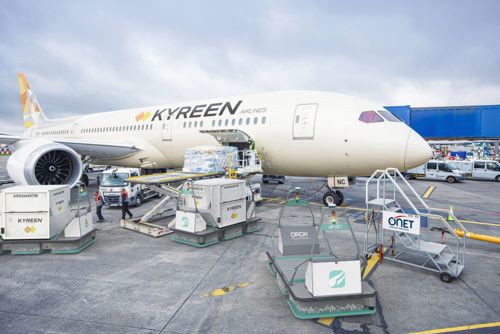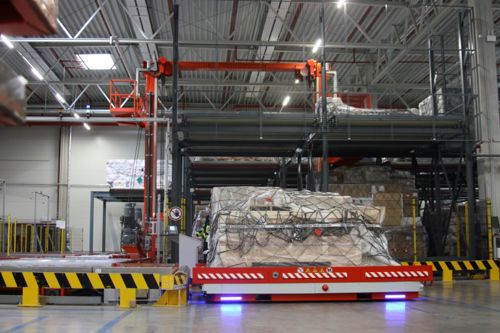
Driver assistance systems such as adaptive cruise control and emergency braking have been available on road cars for years but the concept of driverless cars were the preserve of sci-fantasy until Tesla became a mainstream manufacturer.
At airports, autonomous vehicles are still rare but are developing at quite a rate to move cargo and baggage around airside.
French company Orok had been developing robots for competitions for years but was looking for a practical place to use its technology. CEO Pierrick Boyer said the company looked at several possibilities but was unconvinced before looking at airports.
Boyer said: “We entered the airport by thinking about an autonomous and electric solution for taxiing, and so proposed a much greener solution and less expensive. Our analysis concluded that the project was very complex, and we decided to check other use cases at the airport.”
Baggage and cargo handling would bring much quicker results, it was concluded, and be much less complex than taxiing, both for regulations and complexity.
“Once validated that the use cases were the right one, we designed the solution and checked that we helped resolve a real problem,” he said.
At Paris Charles de Gaulle Airport, Orok has been working with Air France KLM Martinair Cargo and airport operator Groupe ADP, driving a prototype between two warehouses transporting AKE containers.
Boyer said: “The main goals were to prove that we can all have authorisations for an autonomous vehicle to drive in an airport, and to prove that the vehicle can drive within the existing traffic without disturbing the ongoing operations.”
The project was a success and both the airline and airport were happy with the results.
He said: “We had zero accidents or incidents during this period, and they are looking forward for the next phase of the experimentation, which should start in the coming months.”
Implementing experimental technology such as autonomous vehicles is challenging; not only are there regulatory issues but people need to be convinced that it works and is safe. It needs to be easy to use otherwise people will not use it.
In aviation, there is no room for products that are a hazard so maximum safety is vital for the design.
Boyer said: “Both aspects, usability and safety are crucial to go to the market and ensure the project’s success, and this is why we also have several experimentations planned, they allow us to show our seriousness, to show things iteratively, and to get feedback from both users and authorities to improve the solution at each step.”
Technology from driverless cars such as LIDAR has been helpful for Orok but its products are much simpler than road cars, making them cheaper.
He said: “In the end people we are talking to are used to having AGVs or AMRs when talking about warehouses management, especially for the cargo industry, so yes the fact that they know this technology helped us to convince them that it works and how it can be helpful outdoors.”
Clever though autonomous cars are, and the speed at which they have developed is impressive, Boyer does not believe they will be mainstream for some time, mainly due to regulations not being ready. This made the airport a more attractive environment for Orok.
He said: “The airport is an ideal environment as it is a closed environment (or semi-closed), with rules and regulations, with trained professionals and with fewer hazards and situations to deal with.”

Nothing is impossible
Dubai is hot on innovation so is a great place for dnata to test new products. An autonomous tow tractor is being trialled at Dubai World Central (DWC) airport to test the potential of the technology in partnership with Westfield Technology Group. The Westfield autonomous platform is fitted to a converted Charlatte T135 electric Tow Tractor.
Robert Powell, Vice President of Technical Services said airside logistics and point-to-point journeys are the focus but crew transport and GSE staging have potential.
“Westfield themselves already have autonomous pods detecting foreign objects in Aprons (FOD) and operating in Heathrow Terminal 5 Landside and it is a natural evolution of the technology into airside operations,” said Powell.
In an environment demanding such high levels of safety, the technology was approached with trepidation but there are good reasons to embrace change.
He commented: “The recent challenges in recruiting have shown that we must consider these technological solutions, this in-turn could allow upskilling of staff into other areas. There are OEMs offering complete autonomous tractors, but the potential of a retrofit platform, as developed with Westfield, could open the opportunity to implement autonomy on existing vehicles.”
Safety cannot be compromised. Powell said: “This comes through confidence in the location accuracy, objection detection, fail-safe systems, mapping and communication. As we test the technology other observations and considerations are bound to be revealed, but this is why we trial the technology in the differing environments.”
He admits that there are still several unknowns and organisations operating airside face limitations but the technology has great potential and Dubai is the place to test it.
Powell said: “Airport operators need to support the community by improving this, and support technological innovations, such as autonomy. Thankfully for dnata, nothing is impossible in Dubai.”

Putting experience to good use
With almost 50 years of experience in air cargo, Lödige Industries knew that autonomous vehicles had great potential in the cargo warehouse, said Bjorn Ussat, Director Airport Logistics Solutions.
Lödige started developing its automated guided vehicles (AGV) in 2018, showing off the first generation at the Inter Airport Show in 2019. The first one was designed to carry 5ft ULDs and run along floor markings but since then has been upgraded significantly and a larger model has been developed to transport 15 ULDs.
Ussat said: “After extensive testing in our own Technology and Innovation Centre in Paderborn, Germany, the first full size AGV was delivered to Swissport’s Cargo City Süd Terminal in Frankfurt in 2021.”
The cargo terminal is a busy place where heavy and unwieldy objects such as ULDs pallets have to be moved. Any equipment must be fast, accurate, reliable, durable and have a minimal footprint.
“Our AGVs are all of that, but they are also extremely smart, fully integrated into the terminal’s cargo management system Cargo Professional and delivering to schedules that can be changed at any point,” explained Ussat.
Lödige’s AGVs can replace ULD conveyor equipment and slave pallet movers, and they reduce the risk of accidents in the warehouse. Rigid conveyor lines are replaced with flexible access routes that are easily scalable, increasing flexibility and speed inside the terminal.
“AGVs provide the missing connection between individual handling zones inside the terminal 24 hours per day without the need of staffing a slave pallet mover fleet,” he said.
Demand is expected to come from medium and large-sized cargo terminals and the three key trends will be labour shortages increasing pressure to automate manual processes, digitalisation and transparency, and the anticipated growth of global trade and air cargo.
Ussat said: “AGVs are a flexible and safely scalable in-terminal transportation solution, that we believe, cargo handlers will want to access and incorporate either on a purchase or rental basis.”
Safer operations
Autonomous vehicles offer considerable safety and efficiency benefits, says Matt Chaffin, Vice President and General Manager of Textron GSE.
As a company always looking for innovative solutions, autonomous vehicles are of great interest to Textron. Newer products are being built with the intention of supporting autonomous technology.
Chaffin said: “The ramp is a busy environment and AVs can help improve ramp safety by accounting for obstructions, other vehicles, and pedestrians during operations. Reducing vehicle related injuries and aircraft strikes are vitally important on the ramp.”
The biggest hurdles to embracing autonomous technology is infrastructure and customer confidence. He said: “Customer confidence is also a challenge, they are excited about the benefits of autonomous technology, but hesitant that it can deliver the performance necessary to support their operations.”
Take up has been slower in North America compared to Europe or Asia, with Chaffin adding: “With more congested ramps at many European airports, airlines and ground handlers can see the operational and safety benefits that AVs can bring, which generates strong interest.”






